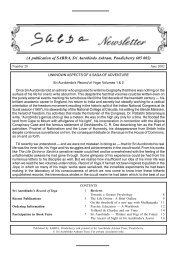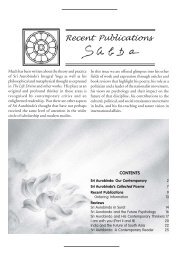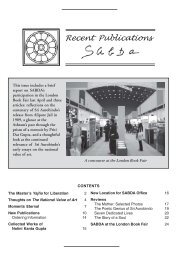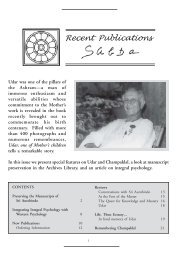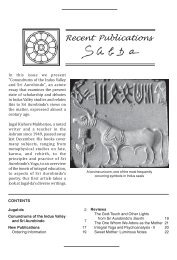November 2010 - Sabda - Sri Aurobindo Ashram
November 2010 - Sabda - Sri Aurobindo Ashram
November 2010 - Sabda - Sri Aurobindo Ashram
Create successful ePaper yourself
Turn your PDF publications into a flip-book with our unique Google optimized e-Paper software.
Many have assumed that the story is modelled on a<br />
chapter from the Mother’s own life, and that this<br />
was probably how she and Henri Morisset separated.<br />
But in my opinion this assumption is incorrect,<br />
firstly, because the Mother never mentioned anything<br />
about it and secondly, because this is a story that<br />
could have happened to anyone in an urban context,<br />
especially in a European context. A married couple<br />
separating was not something so impossible, from a<br />
European perspective at least, that the reader or viewer<br />
would have to find a parallel in the Mother’s own<br />
life to see where the story came from. Some think<br />
that because the heroine has no name, is simply<br />
called “She”, that it must be a way of keeping the<br />
identity of the woman secret. As I have mentioned<br />
earlier none of the characters have a name, it is not<br />
the wife alone who is unnamed.<br />
Moreover, to me it is clear that the story is set in the<br />
time in which it was written. There is a clear reference<br />
at the beginning of the play to “the marvellous<br />
teachings that guide our life”. In her last long<br />
monologue the wife says, “I shall go and join those<br />
through whom we have found the path, they who<br />
hold the eternal wisdom and who have, from a<br />
distance, guided our steps till now. Surely they will<br />
give me shelter.” This could be a reference to the<br />
Mother and <strong>Sri</strong> <strong>Aurobindo</strong> and the <strong>Ashram</strong>. The<br />
woman wants to go to a spiritual community because<br />
she says “surely they will give me shelter”. Either<br />
the Mother meant by that a spiritual community<br />
somewhere in the world or she could have referred<br />
to the <strong>Ashram</strong> itself. If we take the second possibility<br />
to be true then the wife cannot be the Mother herself.<br />
However, as I have mentioned earlier, there are<br />
indications that she might have drawn inspiration<br />
from incidents that she must have seen around her<br />
during her life in Paris. She not only knew several<br />
artists but was connected through them to many<br />
others who were a part of the cultural scene of that<br />
epoch. In this play most of the characters are engaged<br />
in some creative activity and earn a living from it.<br />
We have, thus, the artist, the poet and the singer.<br />
K. R. <strong>Sri</strong>nivasa Iyengar, in his biography of the<br />
Mother, points out that it is very strange that the<br />
poet and the clairvoyant are supposed to be<br />
neighbours, and that too for six months, but they<br />
have never seen each other. This may seem unusual<br />
for Indian towns but it is a perfectly normal situation<br />
in metropolitan cities like Paris where people live in<br />
apartment buildings and may never get to see or<br />
know the people who live in the next building.<br />
The reaction of the audience to our 1995<br />
performance was positive and there was a general<br />
appreciation of our work. The subject of the play<br />
did not bring up any specific comments because it<br />
seemed so normal—in fact, some even said that they<br />
had found the answers to questions and doubts which<br />
they had in their minds. In my desire to be faithful<br />
to the original production I had kept the ladies’<br />
costumes the same as in the first one, but the men<br />
were in kurta-pyjama. Some in the cast had even felt,<br />
as we neared the performance day, that I should have<br />
gone all out to present it as a contemporary play and<br />
given the actors everyday contemporary clothes as<br />
costumes.<br />
Indeed, today, fifteen years after our performance<br />
and sixty years after it was written, the Mother’s play<br />
Towards the Future has a contemporary feel and no<br />
one would feel uncomfortable watching it. In fact,<br />
the title says it all. The Future towards which the<br />
Mother was pointing has come, and now the audience<br />
would be able to understand the need for personal<br />
fulfilment in life, a fulfilment which goes beyond<br />
the satisfaction of finding a partner with whom one<br />
can live the dream of true love. As I write about this<br />
play and think over the issues it deals with, I feel<br />
that, with all the social and cultural changes that<br />
have taken place in India, even over the last decade,<br />
it will surely find an audience which will appreciate<br />
it. Today, even if it means going against social<br />
conventions, there is a greater acceptance of the<br />
individual’s need for spiritual fulfilment.<br />
— Sunayana Panda<br />
Sunayana Panda, who holds an MA in English Literature,<br />
was a student at the <strong>Sri</strong> <strong>Aurobindo</strong> International<br />
Centre of Education. She is on the editorial team of<br />
The Golden Chain, the alumni journal of the SAICE,<br />
and has been actively involved in the staging of many of<br />
<strong>Sri</strong> <strong>Aurobindo</strong>’s literary works.<br />
6



